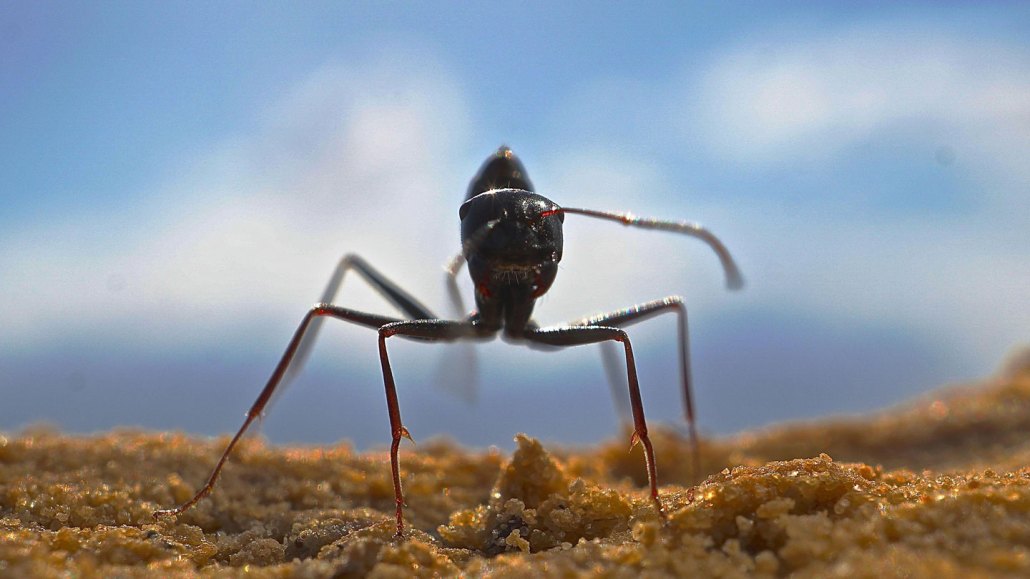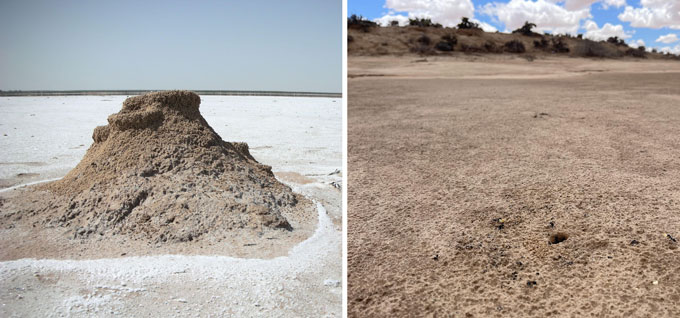
A forager Cataglyphis fortis ant stands on the sandy surface of a hot salt pan while looking for food.
M. Knaden
Some ants have figured out how to keep from getting lost: Build taller anthills.
Desert ants that live in the hot, flat salt pans of Tunisia spend their days looking for food. Successful grocery runs can take the insects as far as 1.1 kilometers from their nests. So some of these ants build towering hills over their nests that serve as a landmark to guide the way home, researchers report in the July 10 Current Biology.
“I am surprised and fascinated that ants have visual acuity at the distances implied in this work,” says ecologist Judith Bronstein of the University of Arizona in Tucson who wasn’t involved in the new study. It “also implies that ants regularly assess the complexity of their local habitat and change their decisions based on what they conclude about it.”
Desert ants (Cataglyphis spp.) use a navigation system called path integration, relying on the sun’s position and counting their steps to keep track of where they are relative to their nest (SN: 1/19/17). But this system becomes increasingly unreliable as distance from the nest increases. Like other types of ants, desert ants also rely more generally on sight and smell. But the vast, almost featureless salt pans look nearly the same in every direction.
“We realized that, whenever the ants in salt pans came closer to their nest, they suddenly pinpointed the nest hill … from several meters distance,” says Markus Knaden, a neuroethologist at Max Planck Institute for Chemical Ecology in Jena, Germany. “This made us think that the hill functions as a nest-defining landmark.”
So Knaden and colleagues captured ants (C. fortis) from nests in the middle of salt pans and from along their shorelines. Only nests from the salt pan interiors had distinct hills, which can be up to 40 centimeters tall, whereas the hills on shoreline nests were lower or barely noticeable.

Next, the team removed any hills and placed the captured insects some distance away from their nests. Ants from the salt pans’ interiors struggled more than shore ants to find home. Since the shore ants were adept at using the shoreline for guidance, they weren’t as affected by the hill removal, the researchers conclude.
The team wanted to know if the ants were deliberately building a taller hill when their surroundings lacked any visible landmark. So, the researchers removed the hills of 16 salt pan nests and installed two 50-centimeter-tall black cylinders apiece near eight of them. The other eight nests were left without any artificial visual aid.
After three days, the researchers found that ants from seven of the unaided nests had rebuilt their hills. But ants from only two of the nests with cylinders had bothered to rebuild.
“These desert ants already told us about path integration and step counting for orientation…. But this business of building your own visual landmark, incredible,” says entomologist John Longino of the University of Utah in Salt Lake City who wasn’t involved in the research. “Are they sitting down to a council meeting to decide whether they need a bigger landmark? Is this somehow an evolved behavior in this one desert ant species?”
For now, it’s unclear how the ants decide to build, or not to build, a hill. Interestingly, nest building is usually performed by younger ants that are not foragers yet, Knaden says, and have not experienced the difficulty in finding a nest in the absence of a hill. That means there is an exchange of information between the veteran foraging ants and their novice nest mates, he says.
Bronstein also wonders about the risks of building the taller structures. Such risks “are implied by the fact that the ants don’t build such a structure where it isn’t needed,” she says. But, “for instance, isn’t it a clear cue to ant predators that food can be found there?”






